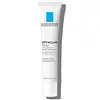What's inside
What's inside
 Key Ingredients
Key Ingredients

 Benefits
Benefits

 Concerns
Concerns

 Ingredients Side-by-side
Ingredients Side-by-side

Water
Skin ConditioningIsononyl Isononanoate
EmollientGlyceryl Stearate
EmollientPentylene Glycol
Skin ConditioningCaprylic/Capric Triglyceride
MaskingPropanediol
SolventCetyl Alcohol
EmollientDimethicone
EmollientC9-12 Alkane
SolventPEG-75 Stearate
Butyrospermum Parkii Butter
Skin ConditioningCaprylyl Methicone
Skin ConditioningPhenoxyethanol
PreservativePolyacrylate Crosspolymer-6
Emulsion StabilisingSodium Hydroxide
BufferingButylene Glycol
HumectantPEG-100 Stearate
Tocopheryl Acetate
AntioxidantGlycerin
HumectantSilica
AbrasiveCeteth-20
CleansingSteareth-20
CleansingLecithin
EmollientCitric Acid
BufferingCoco-Caprylate/Caprate
EmollientHydroxyethyl Acrylate/Sodium Acryloyldimethyl Taurate Copolymer
Emulsion StabilisingSodium Phytate
Tetrahexyldecyl Ascorbate
AntioxidantDiethylhexyl Syringylidenemalonate
Skin ProtectingSqualane
EmollientAlcohol
AntimicrobialRetinol
Skin ConditioningPolysorbate 20
EmulsifyingSodium Benzoate
MaskingT-Butyl Alcohol
PerfumingPotassium Sorbate
PreservativePolysorbate 60
EmulsifyingOryza Sativa Bran Extract
Skin ConditioningBoswellia Serrata Extract
Skin ConditioningHoney Extract
HumectantPotassium Phosphate
BufferingAloe Barbadensis Extract
Skin ConditioningHydrolyzed Vegetable Protein
Skin ConditioningWater, Isononyl Isononanoate, Glyceryl Stearate, Pentylene Glycol, Caprylic/Capric Triglyceride, Propanediol, Cetyl Alcohol, Dimethicone, C9-12 Alkane, PEG-75 Stearate, Butyrospermum Parkii Butter, Caprylyl Methicone, Phenoxyethanol, Polyacrylate Crosspolymer-6, Sodium Hydroxide, Butylene Glycol, PEG-100 Stearate, Tocopheryl Acetate, Glycerin, Silica, Ceteth-20, Steareth-20, Lecithin, Citric Acid, Coco-Caprylate/Caprate, Hydroxyethyl Acrylate/Sodium Acryloyldimethyl Taurate Copolymer, Sodium Phytate, Tetrahexyldecyl Ascorbate, Diethylhexyl Syringylidenemalonate, Squalane, Alcohol, Retinol, Polysorbate 20, Sodium Benzoate, T-Butyl Alcohol, Potassium Sorbate, Polysorbate 60, Oryza Sativa Bran Extract, Boswellia Serrata Extract, Honey Extract, Potassium Phosphate, Aloe Barbadensis Extract, Hydrolyzed Vegetable Protein
Benzoyl Peroxide 5.5%
Water
Skin ConditioningIsostearyl Alcohol
EmollientGlycerin
HumectantPentylene Glycol
Skin ConditioningSilica
AbrasiveCarbomer
Emulsion StabilisingCapryloyl Salicylic Acid
ExfoliatingPotassium Hydroxide
BufferingTocopheryl Acetate
AntioxidantAcrylates/C10-30 Alkyl Acrylate Crosspolymer
Emulsion StabilisingDisodium EDTA
Epilobium Angustifolium Flower/Leaf/Stem Extract
Skin Conditioning
 Reviews
Reviews

Ingredients Explained
These ingredients are found in both products.
Ingredients higher up in an ingredient list are typically present in a larger amount.
Glycerin is already naturally found in your skin. It helps moisturize and protect your skin.
A study from 2016 found glycerin to be more effective as a humectant than AHAs and hyaluronic acid.
As a humectant, it helps the skin stay hydrated by pulling moisture to your skin. The low molecular weight of glycerin allows it to pull moisture into the deeper layers of your skin.
Hydrated skin improves your skin barrier; Your skin barrier helps protect against irritants and bacteria.
Glycerin has also been found to have antimicrobial and antiviral properties. Due to these properties, glycerin is often used in wound and burn treatments.
In cosmetics, glycerin is usually derived from plants such as soybean or palm. However, it can also be sourced from animals, such as tallow or animal fat.
This ingredient is organic, colorless, odorless, and non-toxic.
Glycerin is the name for this ingredient in American English. British English uses Glycerol/Glycerine.
Learn more about GlycerinPentylene glycol is typically used within a product to thicken it. It also adds a smooth, soft, and moisturizing feel to the product. It is naturally found in plants such as sugar beets.
The hydrophilic trait of Pentylene Glycol makes it a humectant. As a humectant, Pentylene Glycol helps draw moisture from the air to your skin. This can help keep your skin hydrated.
This property also makes Pentylene Glycol a great texture enhancer. It can also help thicken or stabilize a product.
Pentylene Glycol also acts as a mild preservative and helps to keep a product microbe-free.
Some people may experience mild eye and skin irritation from Pentylene Glycol. We always recommend speaking with a professional about using this ingredient in your routine.
Pentylene Glycol has a low molecular weight and is part of the 1,2-glycol family.
Learn more about Pentylene GlycolSilica, also known as silicon dioxide, is a naturally occurring mineral. It is used as a fine, spherical, and porous powder in cosmetics.
Though it has exfoliant properties, the function of silica varies depending on the product.
The unique structure of silica enhances the spreadability and adds smoothness, making it a great texture enhancer.
It is also used as an active carrier, emulsifier, and mattifier due to its ability to absorb excess oil.
In some products, tiny microneedles called spicules are made from silica or hydrolyzed sponge. When you rub them in, they lightly polish away dead skin layers and enhance the penetration of active ingredients.
Learn more about SilicaTocopheryl Acetate is AKA Vitamin E. It is an antioxidant and protects your skin from free radicals. Free radicals damage the skin by breaking down collagen.
One study found using Tocopheryl Acetate with Vitamin C decreased the number of sunburned cells.
Tocopheryl Acetate is commonly found in both skincare and dietary supplements.
Learn more about Tocopheryl AcetateWater. It's the most common cosmetic ingredient of all. You'll usually see it at the top of ingredient lists, meaning that it makes up the largest part of the product.
So why is it so popular? Water most often acts as a solvent - this means that it helps dissolve other ingredients into the formulation.
You'll also recognize water as that liquid we all need to stay alive. If you see this, drink a glass of water. Stay hydrated!
Learn more about Water